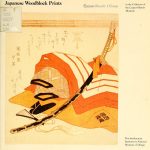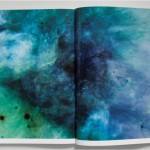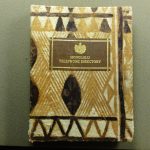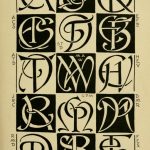 Recently the Smithsonian American Art Museum/National Portrait Gallery Library (AA/PG Library) hosted a tour in conjunction with the 12th Biennial Book Arts Fair and Conference presented by the Pyramid Atlantic Art Center.
Recently the Smithsonian American Art Museum/National Portrait Gallery Library (AA/PG Library) hosted a tour in conjunction with the 12th Biennial Book Arts Fair and Conference presented by the Pyramid Atlantic Art Center.
Category: Art and Design
 This post was written by Elizabeth Brunner, an intern at the American Art and Portrait Gallery Library September-December 2012.
This post was written by Elizabeth Brunner, an intern at the American Art and Portrait Gallery Library September-December 2012.
Joseph Keppler was the predominant political cartoonist of the late nineteenth century. His creation of the magazine, Puck, in 1877 brought him into a national position that allowed him to influence people’s political views and opinions. The magazine featured cartoon and caricature lithographs created by Keppler. The National Portrait Gallery is fortunate enough to own a few of Keppler’s lithographs from the height of his fame during the early 1880s. However, as a bibliophile, I was far more excited to discover that the American Art and Portrait Gallery Library owns one of the 300 copies of a limited-edition book that features some of Keppler’s best lithographs. Published in 1893, this book served Puck as an advertising tool and as a way to promote Keppler’s lithographs and talent.
 Roughly half of the Cultural Heritage Library (CHL), available online here, includes titles from the Smithsonian’s Art Libraries. While copyright restrictions prohibit much coverage of more contemporary titles, the CHL addresses a broad swath of art history’s major movements and themes, including wildly popular and renowned movements like Cubism and Impressionism. Sometimes we isolate historical events; we forget that preceding events and influences play major roles in what comes next. This seems to be especially easy when it comes to art history’s tendency to declare masterpieces and the genius of the artisté. This month we take a look at part of what made Van Gogh and Monet so relevant for their time and enduring into ours: ukiyo-e, the “floating world” of Japanese woodblock prints.
Roughly half of the Cultural Heritage Library (CHL), available online here, includes titles from the Smithsonian’s Art Libraries. While copyright restrictions prohibit much coverage of more contemporary titles, the CHL addresses a broad swath of art history’s major movements and themes, including wildly popular and renowned movements like Cubism and Impressionism. Sometimes we isolate historical events; we forget that preceding events and influences play major roles in what comes next. This seems to be especially easy when it comes to art history’s tendency to declare masterpieces and the genius of the artisté. This month we take a look at part of what made Van Gogh and Monet so relevant for their time and enduring into ours: ukiyo-e, the “floating world” of Japanese woodblock prints.

On Friday, September 28th, the Hirshhorn Museum and Sculpture Garden’s Head Librarian Anna Brooke gave a presentation at the NY Art Book Fair’s Contemporary Artists’ Books Conference on how artists’ books can be used in conjunction with a museum’s collection to provide greater insight into an artist’s body of work. Work studies student Lauren Zook, currently enrolled in the George Mason – Smithsonian collaborative masters program for decorative arts, aided in developing the presentation and has written a summary of it for our blog.
The Hirshhorn Museum and Sculpture Garden Library has acquired an unusual type of book—the artist’s book. Some of these books are mass publications and others are unique and vary in size and shape. A new initiative has been made by the Smithsonian Libraries to make these artists’ books more accessible to the public and protect them from damage. Most of the artists’ books at the Hirshhorn Library were produced by artists represented in the museum’s collection. These artists’ books can provide new insight to an artist’s work, show similar themes, and can even be shown in galleries as autonomous works of art.

The Smithsonian Institution Libraries recently acquired a telephone book. Big deal, you say? Ah, but this is a telephone directory for the territory of Hawaii, issued for the winter of 1930. For that reason alone, it’s fun to browse through, to see the old advertisements and daydream about living in the gorgeous Hawaiian Islands, back in the days when the entire list of businesses and households in the territory which owned telephones could be recorded in one slim volume.
But this isn’t just any old phone book. This particular copy belonged to the Royal Hawaiian Hotel in Honolulu, which opened in February 1927 on the spectacular Waikiki beachfront. Known as “the Pink Palace of the Pacific,” the Royal Hawaiian Hotel was one of the earliest luxury resorts established in this tropical paradise. The stylish décor featured at the Royal Hawaiian Hotel, inspired partly by the native crafts of the South Sea Islanders, exerted a lasting influence upon tourists from the mainland, who came to associate the good life in Hawaii with vivid patterns reminiscent of exotic plants, birds, marine life, sunshine, and ocean waves.

This post was contributed by Rachel Blier, an intern for the American Art and Portrait Gallery Library from June to September 2012.
One of my favorite parts of my time at the AA/PG library has been working with the rare books collection. Between the artists’ books, the unusual cartoons and caricatures in the Ray Smith collection, and the occasional doodle or signature from an artist, it’s a very exciting part of the library—and one that an ordinary visitor wouldn’t have the opportunity to see.
 Typography, the aesthetics of language, gets a lot of attention these days. What was once the purview of specialized professionals is now as common as the PC. The digital revolution’s democratizing impact on publishing has also been a boon for the typographer–or at least the typographer’s eye–in the digital sphere. Even if you aren’t labeling your digital choices as “typography,” chances are you are posing questions that typographers ask. How can font help convey meaning? Why is one font preferable to another? Or even, should this be bold and in red?
Typography, the aesthetics of language, gets a lot of attention these days. What was once the purview of specialized professionals is now as common as the PC. The digital revolution’s democratizing impact on publishing has also been a boon for the typographer–or at least the typographer’s eye–in the digital sphere. Even if you aren’t labeling your digital choices as “typography,” chances are you are posing questions that typographers ask. How can font help convey meaning? Why is one font preferable to another? Or even, should this be bold and in red?
